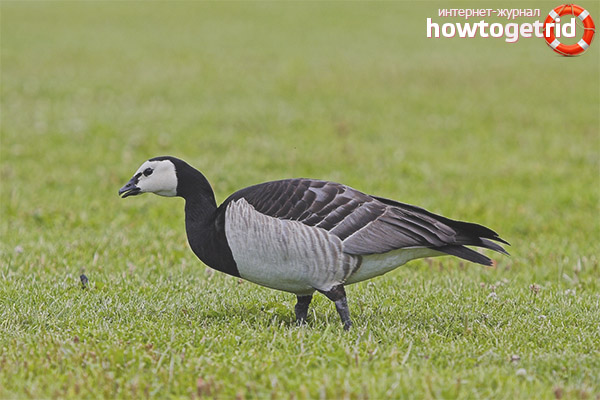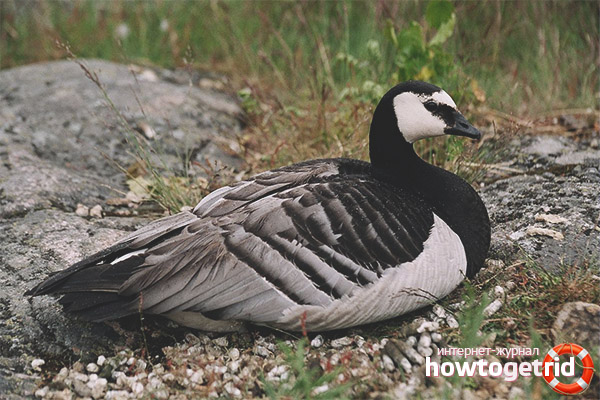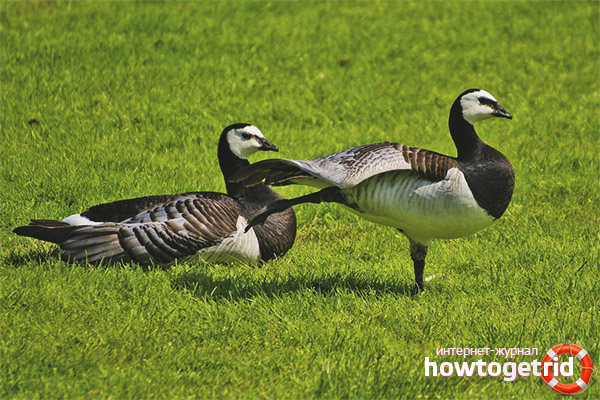The content of the article
White-breasted geese is a beautiful bird of the duck family, which is a rather rare species listed in the Red Book. It is not often found in the vastness of our country. Nevertheless, today the issue of exclusion of this species from the group of the “rarest” birds on earth has become acute. This is due to a sharp increase in the population of white-chested geese in recent years.
The most common type of migratory waterfowl in the southern countries (Italy, Spain). White-breasted geese have a unique appearance, which in fact attracts not only hunters, but also specialists involved in the study of birds.
Interesting facts about the bird
Mention of the white-breasted goose came to us from the distant depths of history and is full of features and rather interesting facts. The most interesting of them relate specifically to the relationship between bird and man. For example, in the XVI century, many believed that this unique bird of the family of ducks does not breed naturally in the usual way for its relatives. The breeding process of the white-breasted goose has been a secret for many for a very long time. The poorly educated population believed the prevailing myth about the appearance of this bird from wood that fell into the sea or ocean. That is, for a long time it was believed that the goose appeared due to the transformation of natural raw materials into a living creature. Sea water miraculously turned the tree that fell into it into amazing small birds with a characteristic white mask on their heads.
Also, the white-breasted goose is also mentioned in the historical chronicles of the Celts. Goose was considered a gift of oceans and seas, which ripened for a long time in shells located in the deep waters of the Atlantic. Due to the fact that the secret of the origin of the bird was not precisely clarified, it was possible to eat goose-goose meat even during a rather strict church fast. However, over time this was forbidden by the lords of the church diocese.
View Features
Such changes imply that this duck, instead of mountainous and rocky terrain, began to choose steppe plains, the coast, and also city slums for its nesting. This helped the bird not only to adapt to the new conditions of the modern world, but also significantly changed its “diet”. Often a white-breasted goose can be found in fairly large European cities, while it also, like pigeons in city squares, asks for passers-by for refreshments, showing its interest and friendliness to people.
Today, such a species of ducks as the white-cheeked geese, reads five main populations:
- Northern Europe, the Arctic (more than one hundred thousand individuals). The place of wintering is Great Britain.
- Greenland (about 40 thousand individuals). The place of wintering is Scotland.
- Svalbard Islands (up to 25 thousand individuals). Wintering place - North of England, Norway.
- North of Russia (about 100 thousand individuals). Wintering place - Holland, West Germany.
- New Earth (a little over 10 thousand). The place of wintering is the Netherlands, Canada.
The appearance of the bird
The appearance of the goose is the most original among most species of the duck family. The bird has a completely black body and a white-headed head. There are small brown marks on the wings. The chest of the bird is decorated with a snow-white apron. Although this bird belongs to the family of ducks, however, it has a rather modest size: the body length rarely exceeds 75 cm, the weight of the bird is up to 3 kg.
The original outfit of the white-breasted geese is somewhat reminiscent of the monastic decoration. In addition, a combination of colors such as white and black is not typical for representatives of the duck family. In nature, there is only one species of bird that looks similar to a white-headed duck - it is a Canadian goose. Nevertheless, the peculiarity of this bird lies in the opposite arrangement of colors - individuals of this species have a completely white body and a black mask on their heads.
Power Features
White-breasted geese are herbivores, and most often their diet consists of tree leaves, plant stems and fresh grass. A special treat for this duck is sedge, mosses, arctic willow, creeping clover. Goose obtains for itself food not only on land, but also in water bodies: algae, small insects, crustaceans, mollusks.
In the cold season, this species of birds is less picky about food, so they often raid farms, while their main goal is vegetable and grain crops.
The peculiarity of this bird is also that it can be kept in captivity. In this case, the goose is fed with grain, grass, vegetables and fresh herbs. Having decided to get such a bird in your household, it should be borne in mind that representatives of this species are completely not adapted to domestic maintenance. Therefore, in order to grow up healthy offspring of white-chested geese at home, care should be taken to organize a daily and fairly long-range walking of birds.
Reproduction of the species
White-breasted geese usually return to their nesting site in late spring, while ducks immediately unite in small colonies, the number of which can reach 70-80 pairs. White-breasted geese do not like crowding, for this reason the distance between the bird nests at the nesting site is quite large - from 10 to 50 m. Accordingly, such an extended arrangement makes the territory selected by these birds for their settlement quite large.
Particularly noteworthy is the behavior of the male duck during mating season. The voice becomes louder and louder, but the bird itself wriggles in unimaginable movements, which should attract the attention of a female. As a rule, such a mating dance is performed by a male white-breasted goose all his life, since he remains faithful to his chosen companion until the end of his days.
To equip the future nest, geese most often choose a small natural depression in the earth's surface. The bottom of such a hole is lined with dry twigs, vegetation, moss and down. During the laying of eggs, the nest with the female is guarded by the male from other birds, who, in case of danger, notifies his girlfriend with a loud cry. The average number of eggs laid by a goose is 6-8, and each bird incubates individually. After the appearance of the chicks, their parents often transfer their offspring to places abundant in dense vegetation. The first attempts of a young goose goose to stand on the wing, as a rule, are carried out closer to two months.
Captivity
In order for the bird to be able to adapt to living conditions on the farm, its owners should recreate the most approximate conditions for the life of the white-breasted goose, which are associated with its nesting and opportunities for proper feeding. Particularly important is a complete and proper feeding for young individuals, which implies the constant presence of fresh herbs.
It is important to take into account the fact that captivity leaves its mark on the immune system of birds, as a rule, more than a third of the new brood chicks do not survive to maturity. Docking of the wings of birds should be carried out by specialists, since many ducks die due to bleeding after incorrect cutting of the wings.
Video: White-cheeked Goose (Branta leucopsis)












Submit